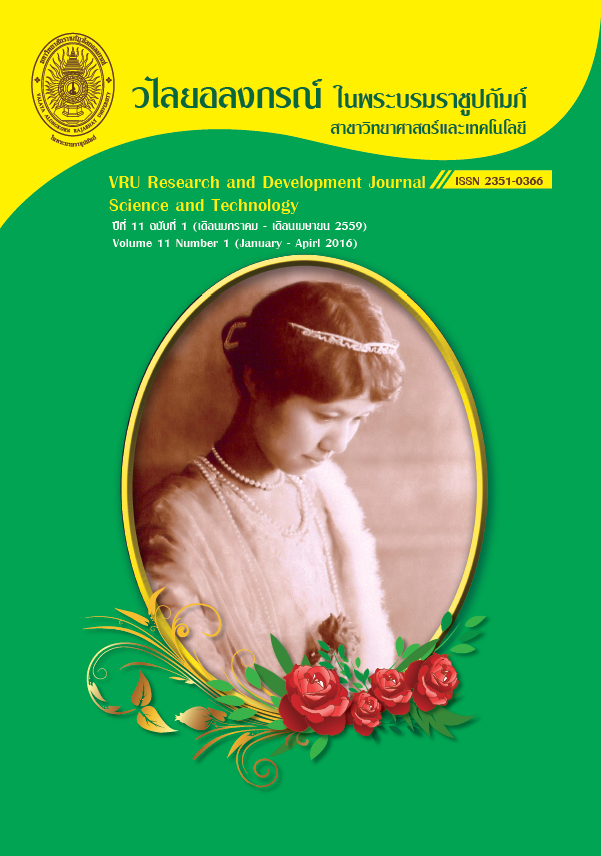การใช้การรับรู้จากระยะไกลเพื่อวิเคราะห์รูปแบบภูมินิเวศของการเปลี่ยนแปลงการใช้ประโยชน์ที่ดิน จังหวัดร้อยเอ็ด
Main Article Content
บทคัดย่อ
การศึกษาครั้งนี้ได้นำภูมิสารสนเทศมาวิเคราะห์การเปลี่ยนแปลงโครงสร้างภูมินิเวศจากการเปลี่ยนแปลงการใช้ประโยชน์ที่ดินจังหวัดร้อยเอ็ด องค์ประกอบทางกายภาพของโครงสร้างภูมินิเวศประกอบด้วย ลักษณะของหย่อม ทางเชื่อม และระบบนิเวศพื้น โดยใช้ภาพถ่ายดาวเทียม Landsat มาใช้ในการวิเคราะห์การเปลี่ยนแปลงการใช้ประโยชน์ที่ดิน ในปี 2550, 2552, 2554 และ 2556 โดยแบ่งการจำแนกการใช้ประโยชน์ที่ดินออกเป็น 7 ชั้นการจำแนกประกอบด้วยนาข้าว พืชไร่ ไม้ยืนต้น ป่าไม้ ชุมชน แหล่งน้ำและพื้นที่อื่นๆ การจำแนกการใช้ประโยชน์ที่ดินด้วยเทคนิค Maximum likelihood โดยผลของการเปลี่ยนแปลงการใช้ประโยชน์ที่ดิน นำมาวิเคราะห์รูปแบบภูมินิเวศเพื่อประเมินการเปลี่ยนแปลง โดยใช้ดัชนีตัวชี้วัดที่ประกอบด้วย จำนวนของหย่อม (NP) ผลรวมเส้นขอบของพื้นที่การใช้ประโยชน์ที่ดิน (TE) ค่าดัชนีขอบความหนาแน่นของหย่อม (ED) เส้นขอบเฉลี่ยของพื้นที่การใช้ประโยชน์ที่ดิน (MPE) ขนาดเฉลี่ยของพื้นที่การใช้ประโยชน์ที่ดิน (MPS) และดัชนีรูปร่างเฉลี่ยของพื้นที่ (MSI)
ผลการศึกษาพบว่าค่า NP ของพืชไร่จะมีค่ามากในปี 2554 ค่า TE และค่า ED ของนาข้าวมีค่ามากที่สุดของทุกๆปี และมีการเปลี่ยนแปลงของไม้ยืนต้นมีการเปลี่ยนแปลงลดลงจากปี 2550 ถึง ปี 2556 ค่า MPE และ MPS ของนาข้าวมากมีค่าเฉลี่ยมากที่สุดของแต่ละปี และค่า MSI ของไม้ยืนต้นมีค่าสูงในปี 2550 และลดลงในปี 2556 ผลจากการวิเคราะห์ดัชนีแสดงให้เห็นว่าการเปลี่ยนแปลงโครงสร้างของภูมินิเวศมีผลมาจากการเปลี่ยนแปลงการใช้ประโยชน์ที่ดิน
This study uses the Geo-information applied to the landscape ecology pattern analysis of land-use change in Roi-Et Province. The physical elements of the ecological landscape includes: Patch Corridor and Matrix. Using Landsat Imagery to analyzed land-use change of the year 2007, 2009, 2011, and 2013 divided the classification of land-use into 7 classes are: Paddy field, Field crop, Perennial, Forest, Urban, Water body, and Miscellaneous land. Maximum likelihood classification was chosen to classifying land use in the study area. The results of land-use change were applied to analyze the landscape ecology pattern to evaluation of landscape change. The landscape assessment by methods of landscape-ecological indexes is: Number of Patch (NP), Total Edge (TE), Edge Density (ED), Mean Patch Edge (MPE), Mean Patch Size (MPS), and Mean Shape Index (MSI).
The results shown that, the NP of field crop was high in year 2011. The TE and ED of paddy field were high in every year and decease of perennial area between years 2007 to 2013. The MPS and MPE of paddy field was an average most of every year and the MSI of perennial area was high in year 2007, and low in year 2013. Finally, the results of landscape-ecological indexes show that the impact of landscape ecology change from the land-use change.
Article Details
ลิขสิทธิ์บทความวิจัยที่ได้รับการตีพิมพ์เผยแพร่ในวารสารวิจัยและพัฒนา วไลยอลงกรณ์ ในพระบรมราชูปถัมภ์ ถือเป็นกรรมสิทธิ์ของสถาบันวิจัยและพัฒนา มหาวิทยาลัยราชภัฏวไลยอลงกรณ์ ในพระบรมราชูปถัมภ์ ห้ามนำข้อความทั้งหมดหรือบางส่วนไปพิมพ์ซ้ำ เว้นแต่จะได้รับอนุญาตจากมหาวิทยาลัยเป็นลายลักษณ์อักษร
ความรับผิดชอบ เนื้อหาต้นฉบับที่ปรากฏในวารสารวิจัยและพัฒนา วไลยอลงกรณ์ ในพระบรมราชูปถัมภ์ เป็นความรับผิดชอบของผู้นิพนธ์บทความหรือผู้เขียนเอง ทั้งนี้ไม่รวมความผิดพลาดอันเกิดจากเทคนิคการพิมพ์
References
ดนัย ทายตะคุ. (2548). “ โครงสร้างเชิงปริภูมิของภูมิทัศน์ กับการวิเคราะห์และการสร้างแบบจาลอง: การทบทวน ทางทฤษฎี ของกระบวนการเชิงปริมาณทางภูมินิเวศวิทยา”. วารสารวิชาการคณะสถาปัตยกรรมศาสตร์ จุฬาลงกรณ์มหาวิทยาลัย, 97-124 .
รวี หาญเผชิญ. (2554). “นิเวศภูมิทัศน์แนวริมแม่โขง จังหวัดหนองคาย”. วารสารวิจัยมหาวิทยาลัยขอนแก่น, 1(2), กรกฎาคม - กันยายน 2554.
Martin, H., Joseph, S., and Keith, C. C., (2002). “The Use of Remote Sensing and Landscape Metrics to Describe Structures and Changes in Urban Land Uses”. Environment and Planning , 34, 1443 -1458.
Ramachandra T.V., Bharath H. A., and Sreekantha S., (2012). “Spatial Metrics Based Landscape Structure and Dynamics Assessment for an Emerging Indian Megalopolis”.International Journal of Advanced Research in Artificial Intelligence, 1(1).

